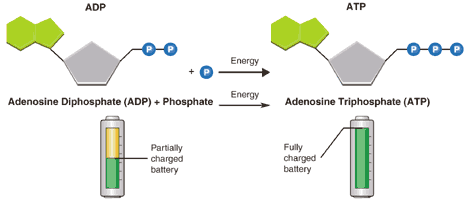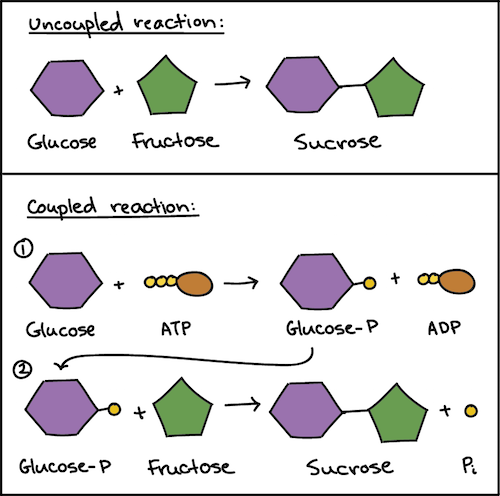Describe How Atp Is Used for Energy Transfers
Adenosine triphosphate ATP is the source of energy for use and storage at the cellular level. Adenosine triphosphate ATP is the energy currency for cellular processes.

Topic 2 8 Cellular Respiration Amazing World Of Science With Mr Green
The body is a complex organism and as such it takes energy to maintain proper functioning.

. Adenosine triphosphate also known as ATP is a molecule that carries energy within cells. All living things use ATP. When the cell requires energy ATP is broken down through hydrolysis.
Through the production of ATP the energy derived from the breakdown of sugars and fats is redistributed as packets of chemical energy in a form convenient for use elsewhere in the cell. It is the only energy which can be directly used for different metabolic process. In this process a food molecule breaks down in mitochondria may consume oxygen and transfer energy to cells in which it is.
Roughly 10 9 molecules of ATP are in solution in a typical cell at any instant and in many cells all this ATP is turned over that is used up and replaced every 12 minutes. ATP provides the energy for both energy-consuming endergonic reactions and energy-releasing exergonic reactions which require a small input of activation energy. The high energy bond is broken and a phosphoryl group is removed.
ATP synthesis utilizes energy obtained from multiple catabolic mechanisms including cellular respiration beta-oxidation and ketosis. Describe the process of energy transfer from NADH and FADH to the proton motive force. Describe the role of ATP in energy transfer.
Other forms of chemical energy need. Its energetically unfavorable to move sodium out of or potassium into a typical cell because this movement is against the concentration gradients of the ions. Describe the aerobic production of.
For more information look up Electron Transport Chain. Microorganisms capture and store energy metabolized from food and light sources in the form of ATP. Describe the role of ATP in energy transfer.
ADP has two phosphate groups and ATP has three phosphate groups. Its composed of a ribose sugar an adenine base and 3 phosphates. When the ATP is broken down you have phosphate groups that release energy and it converts it into ADP.
The process by which mitochondria use to transfer the energy in foods to ATP is known as cellular respiration. ATP serves at the primary energy transfer molecule within the cell because of its stability and ease of energy release. In essence the ATP is used in various chemical reactions that need energy as a booster for these reactions.
Be sure to include how free energy is changing and what the sources of energy are in each. ATP is the form of energy used by all living things. ATP contains 76jmole of energy which we can identify as the E.
Describe how energy is stored in a molecule of ATP. Describe how the proton-motive force is converted into ATP. It is the main energy currency of the cell and it is an end product of the processes of photophosphorylation adding a phosphate group to a molecule using energy from light cellular respiration and fermentation.
The reduced energy carrier NADH can then donate 2 electrons to another molecule restoring the oxidized form of NAD. The energy released from this process is used to drive various cellular processes. In this manner why is glycolysis described as having an energy investment phase and an energy payoff phase.
ATP contains a high energy bond which is used to transfer energy inside cells. This chemical substance is made up of adenosine and 3 phosphate molecules. Also there is energy in the entropy due to a chemical change which for the two states is kln2.
ATP and ADP are two types of nucleotides mainly involved in the transfer of energy between biochemical reactions in the cell. It uses stored ATP and then forms a net increase in ATP. To release energy one of these phosphates breaks off which then makes ATP become ADP adenosine diphosphate.
Animals eat the plants so they can use the sugar to make their own form of chemical energy ATP. Describe the process of energy transfer from the proton motive force to ATP. ATP serves as an extracellular signalling molecule and acts as a neurotransmitter in both central and peripheral nervous systems.
Describe how ATP is produced and explain why ATP cannot be used as an energy storage molecule. The energy yielding reactions are regulated by enzymes that transfer the energy into biosynthesis. Both ATP and ADP are composed of a ribose sugar adenosine and phosphate groups.
Identify the factors that make ATP an energy-rich molecule. The ATP acts as the energy currency for the energy coupling process. This energy is then used to form the bonds that build other organic molecules.
ATP is found in cells of all living things and is responsible for almost all cellular processes. In organisms energy coupling is typically shown based on ATP production and hydrolysis. ATP is the energy currency of all of our cells.
Scientists use the term bioenergetics to describe the concept of energy flow through living systems such as cellsCellular processes such as the building and breaking down of complex molecules occur through stepwise chemical reactionsSome of these chemical reactions are spontaneous and release energy whereas others require energy to proceed. Substrate level phosphorylation is the process by which ATP is produced from the transfer of a phosphate group from a substrate molecule in a metabolic pathway. During catabolism many of the enzymes couple an energy yielding reaction to the formation of ATP.
When the chemical bonds within ATP are broken energy is released and can be harnessed for cellular work. As ATP is used for energy a phosphate group or two are detached and either ADP or AMP is produced. The more bonds in a.
Describe how ATP is produced and explain why ATP cannot be used as an energy storage molecule. The electron transport chain is where ATP is produced in the inner membrane of mitochondria ATP carries chemical energy that cells can use. Organisms such as prokaryotes and eukaryotes use respiration mechanisms for the breakdown of food that may require environmental oxygen.
The work or useful energy extracted is the change in the energy from the lower portion of the well to the higher. ATP provides energy for the transport of sodium and potassium by way of a membrane-embedded protein called the sodium-potassium pump NaK pump. The easiest way to think about ATP is like a.

Chapter 4 Atp And Energy Release Ppt Video Online Download

0 Response to "Describe How Atp Is Used for Energy Transfers"
Post a Comment